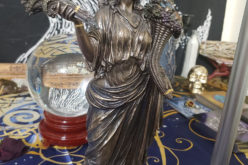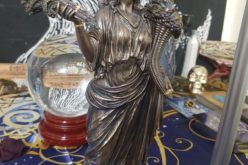The Dark Goddesses: Evil can be in the eye of the storyteller
This week I am touching on the subject of misogyny in ancient mythology. Throughout centuries, in many different cultures, women were seen as lesser in comparison to men. That being said, the lore of certain goddesses was changed to put women at fault or seem aggressive or sometimes both. A lot of our work as priestesses involves invoking the goddess; this is the process of setting our ego aside and allowing deity to use our body as a vessel of their own. This is so we can hear her, feel her, and learn from her. A good example of this would be the story of Izanami-no-Mikoto and her mythology as compared to working with her through invocation.
This story begins when creation deities Izanami and Izanagi wished to marry. They had asked the elder gods for their permission to get married. The ancient ones had granted permission, and they had walked around the pole in what was an ancient custom for marriage and fertility. Izanami had given birth to a deformed child, and they were told to try again, because Izanami had walked around the pole first. And with another failed attempt, they were told to try again because she had spoken first. And so, upon the final and successful attempt, Izanami had given birth to the fire god who had burned her during childbirth, so badly she later passed away from her injuries.
Izanagi suffered terrible grief, and he asked the elder gods to bring his wife back from the dead. Seeing how distraught Izanagi had become, the ancient ones accepted his request with one condition — that he was to be patient in awaiting her return. Because in the underworld you do not have form, you do not have a name, the only thing that you have is your soul in its purest form. So to bring her back, the ancient ones had to reverse death, which means they had to reverse decay on her body to bring her body back to a living state.
As days went on, Izanagi and his grief became nearly unbearable. His pain continued to grow, and his patience grew shorter. Izanagi did not follow through with the conditions set onto him; he made his descent to the underworld, in the Shinto religion called Yomi. It was dark in Yomi, and Izanagi traveled the underworld with a torch. Reaching his wife, he lit the torch underneath her, and her sight was appalling to him. Izanagi was not expecting to see the love of his life in such a state of ugly decay. Izanami was not awake when he found her because the ancient ones had to put her in a deep sleep — sort of like a trance — to bring her back and reverse the effects of death. So she was not aware of her state of decay and did not understand why her husband found her to be ugly.
This is where the difference happens in what is told in mythology and the true story told by Izanami during invocation and working with her. In mythology it is said that Izanami became angry and violent, chased Izanagi through Yomi and sent several ugly women chasing after him. Also, in the mythology once they had reached the gates of Yomi, Izanami had threatened to kill 1,000 souls a day if her husband did not take her back. In response, Izanagi said he would create 1,000 souls a day to balance that out. This is how they became deities of death and creation.
However, in working with Izanami I have found that not to be entirely true. She did chase after him, only because she was confused as to why her loved one was so frightened of her, and she wanted an answer. She was not angry; she did not send angry ugly women after him; and she did not threaten to kill 1,000 souls a day. Izanami became a goddess of death because she went through extensive shadow work, which is accepting negative aspects about ourselves and growing from it. She learned that she did not have to rely on others and their opinions to determine her beauty. Izanami came to the realization that she was a goddess all on her own; she did not need to lean on anyone to determine her strength or her abilities as a goddess. She had also come to the realization that as a woman she was powerful.
Now, there was shadow work involved for Izanagi as well; both deities are amazing in their own ways, and I’m not at all saying that one of them is a terrible person. In pagan and Wiccan religion, deities learn and grow from their mistakes just as we do, and each story told about a god or goddess has purpose and meaning when it comes to teaching us about our struggles.
With this being said, there are many other goddesses who are considered to be dark goddesses only because the stories told by man have made them out to be vengeful, angry and destructive. In the next couple of weeks, I am going to give you a few more examples of this in an article series I am naming “The Dark Goddesses.”
Raven Ebonywing serves as the Microsoft Teams events coordinator for Aquarian Tabernacle Church International. She is a second-year student at Woolston-Steen Theological Seminary and student of Lady Belladonna Laveau. She also serves as the high priestess in the WISE tradition of Creation’s Grimoire Church of Wicca in Bentonville and is a member of the Benton County Interfaith Alliance. Email her at CreationsGrimoire@gmail.com.






